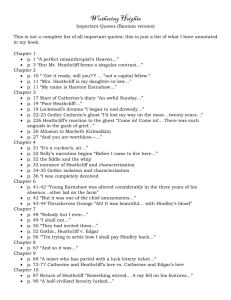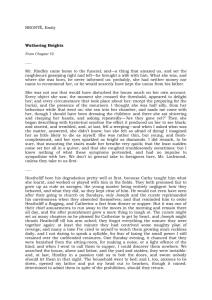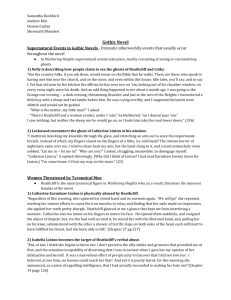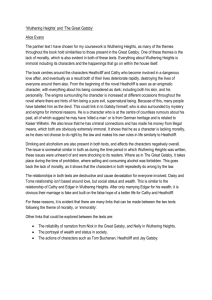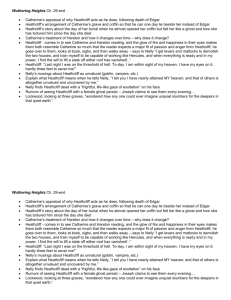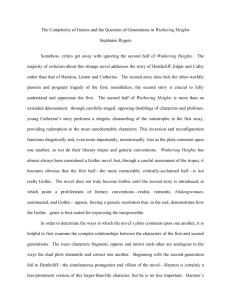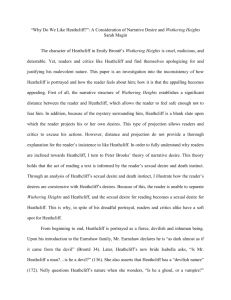Wuthering Heights and the Gothic
advertisement
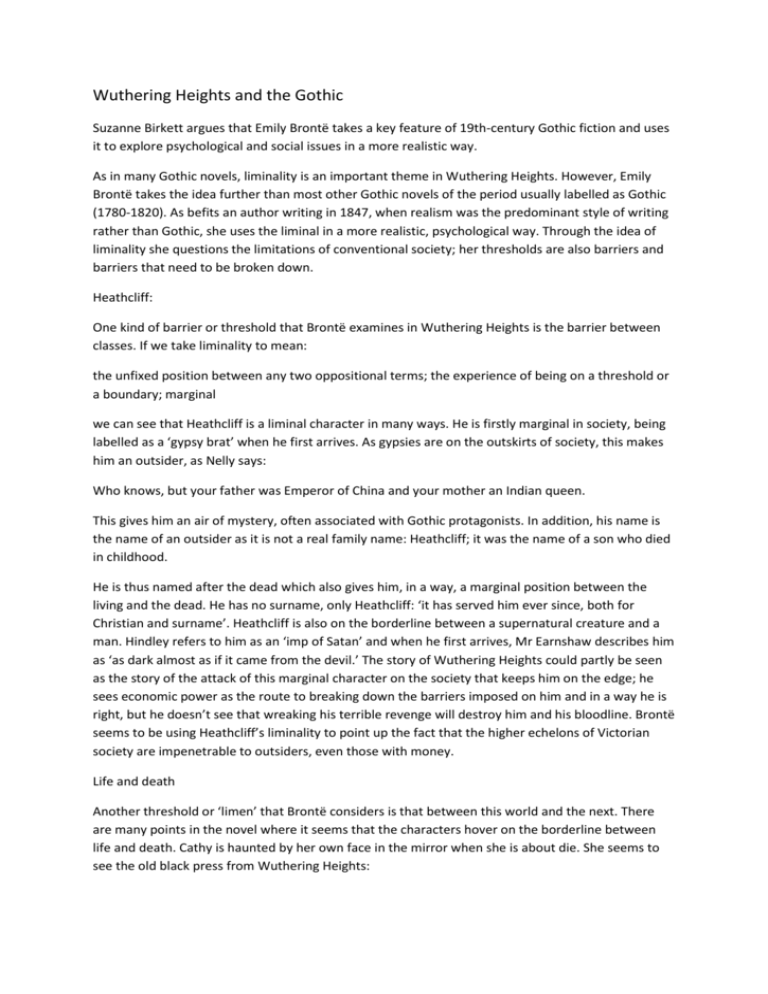
Wuthering Heights and the Gothic Suzanne Birkett argues that Emily Brontë takes a key feature of 19th-century Gothic fiction and uses it to explore psychological and social issues in a more realistic way. As in many Gothic novels, liminality is an important theme in Wuthering Heights. However, Emily Brontë takes the idea further than most other Gothic novels of the period usually labelled as Gothic (1780-1820). As befits an author writing in 1847, when realism was the predominant style of writing rather than Gothic, she uses the liminal in a more realistic, psychological way. Through the idea of liminality she questions the limitations of conventional society; her thresholds are also barriers and barriers that need to be broken down. Heathcliff: One kind of barrier or threshold that Brontë examines in Wuthering Heights is the barrier between classes. If we take liminality to mean: the unfixed position between any two oppositional terms; the experience of being on a threshold or a boundary; marginal we can see that Heathcliff is a liminal character in many ways. He is firstly marginal in society, being labelled as a ‘gypsy brat’ when he first arrives. As gypsies are on the outskirts of society, this makes him an outsider, as Nelly says: Who knows, but your father was Emperor of China and your mother an Indian queen. This gives him an air of mystery, often associated with Gothic protagonists. In addition, his name is the name of an outsider as it is not a real family name: Heathcliff; it was the name of a son who died in childhood. He is thus named after the dead which also gives him, in a way, a marginal position between the living and the dead. He has no surname, only Heathcliff: ‘it has served him ever since, both for Christian and surname’. Heathcliff is also on the borderline between a supernatural creature and a man. Hindley refers to him as an ‘imp of Satan’ and when he first arrives, Mr Earnshaw describes him as ‘as dark almost as if it came from the devil.’ The story of Wuthering Heights could partly be seen as the story of the attack of this marginal character on the society that keeps him on the edge; he sees economic power as the route to breaking down the barriers imposed on him and in a way he is right, but he doesn’t see that wreaking his terrible revenge will destroy him and his bloodline. Brontë seems to be using Heathcliff’s liminality to point up the fact that the higher echelons of Victorian society are impenetrable to outsiders, even those with money. Life and death Another threshold or ‘limen’ that Brontë considers is that between this world and the next. There are many points in the novel where it seems that the characters hover on the borderline between life and death. Cathy is haunted by her own face in the mirror when she is about die. She seems to see the old black press from Wuthering Heights: It’s against the wall as it always is. It does appear odd – I see a face in it. Nelly says: That is the glass – the mirror, Mrs Linton; and you see yourself in it, and there I am too by your side. It is almost as if Cathy is a ghost before she is dead and is haunting herself. First Cathy and then Heathcliff long for the world beyond. Cathy says, ‘I’m wearying to escape into that glorious world.’ Both characters are trapped by the conventional borders of society which act as limits to their passion. Cathy cannot marry Heathcliff because he is a liminal character on the borderline of society; she has to choose Edgar who has high status in society and thus confines herself to a low-burning sort of love and entrapment symbolised by the ‘lattice’ of the Grange. She opens the window to feel the air coming ‘straight down the moors’ from Wuthering Heights when she is ill and thus ‘transgresses’ the border into the other world beyond life, the only place where she can be with the man for whom she feels a much stronger, more passionate love. It seems that Brontë herself advocates this kind of transgression. When Cathy dies, Heathcliff feels the same need to be with Cathy after death and he is prepared to transgress in order to achieve his aim: every night I’ll haunt the place and every day, till I find an opportunity of entering. This harks back to Cathy’s ghost in Ch3 that wants to come in. Lockwood says he breaks the barrier: knocking my knuckles through the glass...I pulled its wrist on to the broken pane, and rubbed it to and fro till the blood ran down and soaked the bedclothes. Here the window pane acts as barrier between the real world and the supernatural. In this same chapter, Heathcliff has to transgress to gain access to Cathy in the world beyond. He wrenches open the window which Lockwood had noticed was ‘soldered into the staple’. His transgression is more extreme when on the evening of the day Cathy is buried, Heathcliff tells Nelly that he partially exhumed her grave: I said to myself – ‘I’ll have her in my arms again. [He is] on the point of attaining my object when it seemed that I heard a sigh from some one above.’ When Heathcliff finally dies, his transgression of the boundary between life and death is symbolised once again in the image of the open window: The lattice, flapping to and fro had grazed one hand that rested on the sill – no blood trickled from the broken skin. Eyes are also used in the book as a portal to the other world. Heathcliff’s eyes always seem supernatural and connected with the underworld and devils. When he returns they are described by Nelly as ‘black fires’. When he dies, Nelly tries to shut his eyes: They would not shut – they seemed to sneer at my attempts, and his parted lips and sharp white teeth sneered too. It can be argued that they symbolise the idea that he has crossed the boundary into death and is together with Cathy. Ghosts – a liminal state At the end of the book it appears that the borders between life and death are broken down and that the ghosts of Heathcliff and Cathy hover together in a liminal state. Joseph swears that he has seen them both looking out of the window ‘on every night since his death.’ And the little shepherd boy says he has seen Heathcliff and a woman under the Nab. Brontë is perhaps more Romantic than Gothic in sensibility in suggesting that strength of passion can transcend this world and lead to a spiritual world beyond. The restrictions of Victorian society leave no room for this strength of passion or for a cross-class relationship to succeed, and Brontë has to try to please her readers by restoring the order in society at the end by making Catherine and Hareton happily join together the gentlemen-farmer Earnshaws with the upper-class Lintons. Despite this she uses the Gothic idea of the supernatural and the transgressed ‘limen’ to demonstrate the importance to her of a passion that lasts beyond death. Nature and culture A third kind of barrier that is broken in the novel is that between nature and culture. When Cathy and Heathcliff visit Thrushcross Grange they look into the Grange through the barrier of a window; here the window could be seen to symbolise the border between nature outside and culture within. When Heathcliff tells his story to Nelly he says: If Catherine had wished to return, I intended shattering their great glass panes to a million fragments, unless they let her out. Here Heathcliff feels excluded from the culture and feels that Cathy is trapped behind the panes as if in a prison. Although Cathy at this point does not want to escape, she later marries Edgar and comes to feel that she is imprisoned by society’s rules. Lockwood also breaks down the barrier between nature and culture in Ch3 where the window pane symbolises more than just the barrier between life and death. It is also the portal between basic instinct and civilisation. Lockwood is afraid when he breaks the pane and lets the hand of Cathy come in. It is almost as if he opens the door to his underlying instinctive (possibly sexual) impulses and is afraid of them disturbing his civilised surface. He hurriedly piles ‘the books up in a pyramid against it’, thus using the power of civilisation against passions he doesn’t want to feel. This idea is also explored in another novel sometimes described as Gothic, Dr Jekyll and Mr Hyde by Robert Louis Stevenson (1886) where Hyde is the embodiment of the wild passion and Dr Jekyll of civilisation, but here the idea is taken further as the two are one and the same person. Finally, it is interesting that Cathy’s final resting place is part nature and part culture. Although it is in the civilised graveyard: heath and bilberry plants have climbed over it from the moor; and peat mould almost buries it. Her grave is therefore in itself liminal and echoes the way in which she has finally transcended her earthly boundaries in death. Emily Brontë seems to be saying that in people like Heathcliff and Cathy their passions are too strong to be contained by earthly barriers. When Heathcliff describes Cathy, she is someone whose feelings are too strong to be contained: the sea could be as readily contained in that horse-trough and Edgar: might as well plant an oak in a flower-pot. Brontë thus uses liminality to show that society’s borders and barriers are too confining – there has to be room in life for nature and strong feelings to break through. Suzanne Birkett, previously Editorial Director of BBC Books, has been teaching English since 2002. She is now second in the English Department at Sir William Borlase’s Grammar School. This article first appeared in emagazine 46, December 2009.

